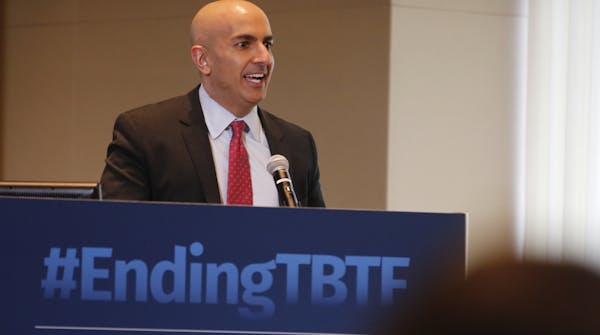Honing his argument and showing no diminishment of resolve, Neel Kashkari on Monday insisted that the largest banks in the United States are still too big to fail and that taxpayers will likely be on the hook for another bailout the next time one of them gets in trouble.
Speaking to the Minnesota Chamber of Commerce, the president of the Federal Reserve Bank of Minneapolis batted away criticism and returned to his central assertion — that faced with another financial crisis, government officials will not be able to force the bondholders of large banks to take massive losses without also putting the entire economic system at risk.
"I fear that policymakers will have to turn to taxpayers rather than creditors to impose losses," he said.
Kashkari is forging ahead despite widespread skepticism from financial executives who are confident in the strength of the industry and the post-crisis regulations that govern it. In a question-and-answer session after his Monday speech, Kashkari's comments were especially pointed.
He weighed in on a bellwether late-March decision by a federal judge in Washington that ruled MetLife, the insurance giant, is not too big to fail, contrary to the opinion of the Federal Reserve's Financial Stability Oversight Council. Kashkari likened MetLife to a diseased patient who sought a second opinion because it didn't like the diagnosis.
"That's basically what MetLife just did. They didn't like the diagnosis, so they sued, they got a judge to side with them and they said 'Look, we're not systemic anymore' because some judge went their way," Kashkari said. "That doesn't change the risk they pose to the U.S. economy."
He smiled when he was asked to respond to a recent comment by Jamie Dimon, chief executive of JPMorgan Chase, that he didn't want Americans 20 years from now to wonder how the nation's big banks "lost their leadership position … [to] someone else and likely a Chinese bank."
"The ultimate scare tactic — he invoked the Chinese," Kashkari said, suggesting Dimon had no better argument. "That's almost like waving a white flag."
Kashkari said that if multinational companies can manage thousands of supplier relationships, they can surely manage several banking relationships and most already do.
A safer banking system comes with trade-offs, he said. In exchange for less frequent and severe financial crises, the country would likely have to pay with higher borrowing costs due to the heavier regulatory and capital burdens on banks.
But, he said, any cost-benefit analysis of a proposal for restructuring the financial system should consider not just the rate of economic growth between downturns but also the depth of the downturns and their effect on long-run economic growth. It's not at all clear, Kashkari argued, that Main Street is better off with a financial system that suffers severe downturns but helps stimulate faster growth in times of prosperity.
Kashkari gave his thoughts on two big remedies — raising capital requirements and breaking up the big banks — that were discussed at an April 4 symposium on ending too big to fail, the first of several such meetings the Minneapolis Fed will host this year.
"There is a strong argument that simpler solutions are more likely to be effective than complex ones, so I see virtue in focusing on increasing common equity to assets," he said.
On breaking the nation's biggest banks, Kashkari said that many participants in the April 4 meeting, including himself, were concerned about the possibility of government analysts arbitrarily dividing them up. But he also noted that new requirements since the 2008 crisis have led major financial institutions to shed some operations. "I believe that given sufficient incentive, banks would be able to restructure themselves," he said.
Kashkari pointed to the Treasury's Troubled Asset Relief Program, or TARP, and the taxpayer bailouts of Fannie Mae and Freddie Mac as examples of why a taxpayer bailout could well be necessary again in the future. The rationale for TARP — that the financial system was under threat of a panic among skittish creditors — is well-known. Treasury injected capital simultaneously in several financial institutions — some of them more healthy than others — in order to protect creditors of the least healthy companies and prevent a systemwide collapse.
Fannie Mae and Freddie Mac, Kashkari said, started in 2001 issuing "subordinated debt" with the specific intention that it would be available to absorb losses if the government-sponsored enterprises ran into trouble. Those creditors who purchased the subordinated debt received higher yields in exchange for the higher risk of losses. But because of widespread risk in the financial markets, the Treasury chose to use taxpayer money to protect that debt "rather than haircut it."
In other cases, Kashkari said, debt issued by financial institutions that was specifically structured to absorb losses never was haircut. Large banks that sponsored off-balance-sheet structured investment vehicles were under no legal obligation to provide a financial backstop for them, and yet, for reputational reasons, they did.
Convertible debt that would be turned into equity in the event of a collapse, an idea floated by several economists, is also probably not a solution, Kashkari said. Recent volatility for this type of debt, particularly in Europe, highlights the complexity of the mechanism and the uncertainty it can create, and calls into question whether it will even be more attractive for banks as a means of raising capital than issuing straightforward equity capital.
Kashkari stressed to the audience at the Minneapolis Club on Monday that he has yet to settle on a specific proposal. The second symposium at the Minneapolis Fed will be May 16.
Adam Belz • 612-673-4405 Twitter: @adambelz
